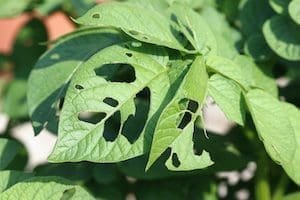It’s summer in St. Louis and no surprise – it’s hot. But the heat isn’t the only threat your plants may face this summer. It’s also the prime time for Japanese beetles to feed, lay their eggs, and generally wreak havoc on gardens across the state. In this post, we’re going to focus primarily on how to get rid of Japanese beetles, but we’ll also give you an idea of how to spot these pests.
Signs That You Have Japanese Beetles
The following are indicators that your plant or garden is infested with Japanese beetles.
- Your plants’ leaves are “skeletonized,” meaning that much of the leaf has been chewed away, leaving only the veins intact.
- Your lawn has patches of dead, brown grass. This is caused by Japanese beetle grubs that have spent the winter in the soil, feeding on grass roots.
- Fruits and flowers in your garden show signs of insect feeding.
- You see them! It’s fairly easy to see Japanese Beetles with the naked human eye. They have shiny, blue-green heads and copper-colored abdomens. They are generally metallic in appearance, and about ½ inches in length.
Japanese beetles have been known to feed on up to 300 different species of plants. So, they might show up on nearly any plant in your garden. However, Japanese beetles particularly enjoy rose bushes. If you’re seeing skeletonized leaves on your rose bushes, these pests just might be your culprit. That said, don’t rule out any other common tree pests until you have seen and can confirm you have Japanese Beetles.
Japanese Beetles will “skeletonize” your leaves.
How to Get Rid of Japanese Beetles
So you’ve determined that your garden has Japanese beetles. Now what? Below, we’ve outlined a number of solutions for getting rid of Japanese beetles.
- Pick them off. Japanese beetles aren’t the fastest moving pest, so it’s fairly easy to hand-pick them off your plants. Dispose of them by dropping them into a bucket of soapy water.
- Spray with soapy water. Make a simple spray by mixing 4 tablespoons of soap with water in a spray bottle. Spray on any beetles you can find.
- Use a drop cloth. Cover your plants at night with a large sheet or drop cloth. Then, remove the cloth in the morning (when beetles are most active) and shake them off into a bucket of soapy water.
- Apply milky spore. Milky spore causes disease in Japanese beetles. Buy it at your local garden store and apply it to your lawn, ideally in the spring before the adult beetles have emerged from the earth. This will ensure that beetles don’t return to your garden next year. For best results, repeat this process every spring for at least three years. It’s also advisable to purchase a nematode and apply it with the milky spore, so that the disease spreads even more quickly through the beetle population.
- Apply neem oil. This is another longer-term solution. Spray neem oil onto the plants infested with Japanese beetles, and the beetles will ingest it along with plant matter. When the beetles mate, they will pass along certain chemicals in the oil, which prevent their eggs from maturing into adult beetles.
One method we wouldn’t recommend is using commercial Japanese Beetle traps. The reason is that these traps often end up attracting beetles from all over – not just your yard. The bait is so powerful, beetles often migrate from neighboring gardens to investigate. What’s more, these traps only capture about two-thirds of the beetles they attract. So, you may actually end up with more beetles than before.
We hope that one or more of these methods works for you. But if not, reach out to our team – our plant health care specialists can advise you in getting your garden beetle-free.


